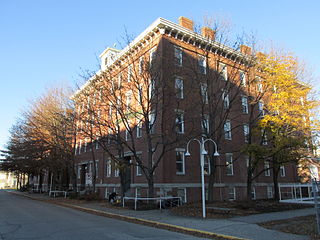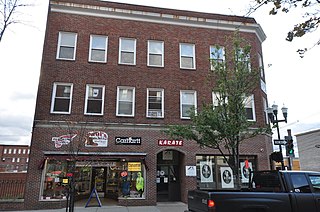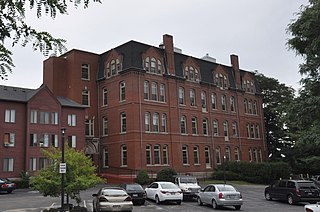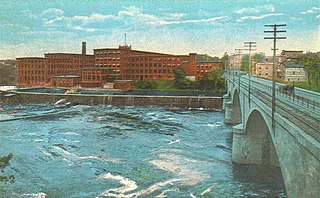
Lewiston is the second largest city in Maine and the most central city in Androscoggin County. The city lies halfway between Augusta, the state's capital, and Portland, the state's most populous city. It is one-half of the Lewiston-Auburn Metropolitan Statistical Area, commonly referred to as "L/A." or "L-A." Lewiston exerts a significant impact upon the diversity, religious variety, commerce, education, and economic power of Maine. It is known for an overall low cost of living, substantial access to medical care, and a relatively low violent-crime rate. In recent years, the City of Lewiston has also seen a spike in economic and social growth. While the dominant language spoken in the city is English, it is home to the largest French-speaking population in the United States while it is second to St. Martin Parish, Louisiana, in percentage of speakers.

The Saxony Mill was a historic textile mill complex at 66 West Street in Rockville section of Vernon, Connecticut. With a construction history dating to 1836, it was one of the oldest surviving wood-frame textile mills in the state prior to a 1994 fire which led to its demolition. The mill complex was added to the National Register of Historic Places in 1983.

Harmony Mills, in Cohoes, New York, United States, is an industrial district that is bordered by the Mohawk River and the tracks of the former Troy and Schenectady Railroad. It was listed as Harmony Mills Historic District on the National Register of Historic Places in 1978. A portion of the district encompassing the industrial buildings and some of the housing built for millworkers was declared a National Historic Landmark in 1999. The centerpiece building, Harmony Mill No. 3 was listed on the National Register of Historic Places in 1971.

The Valley Falls Mill is a historic textile mill complex on Broad Street in Central Falls, Rhode Island. The complex consists of the primary mill building, a large Italianate brick four-story building erected in 1849, several outbuildings. a dam across the Blackstone River, and a portion of the original canal system which provided water power to the mill. The outbuildings include the gatehouse controlling waterflow into the canals, a small stuccoed office building now serving as a retail establishment, and a brick bathhouse built c. 1870 that stands just south of the mill race. The complex originally had a second mill building and power canal; that building was destroyed by fire, and its canal was filled in. The main mill building was developed as housing in the late 1970s, including a sympathetic replacement for the second mill building.

The Barker Mill is an historic mill at 143 Mill Street in Auburn, Maine. Built in 1873, this five-story brick mill building is one a relatively few in the state that has a mansard roof, and has a higher degree of decorative styling than other period mill buildings. It was the first major mill on the Auburn side of the Androscoggin River. It was listed on the National Register of Historic Places in 1979, and is now residential housing. It was built in the Second Empire architectural style.

The Continental Mill Housing buildings are a pair of historic mill worker housing blocks at 66-82 Oxford Street in Lewiston, Maine. The Greek Revival/Italianate housing units were built in 1866, and are all that remain of a large number of similar buildings that once lined Oxford Street. These two buildings were listed the National Register of Historic Places in 1979.

The First McGillicuddy Block is an historic commercial building at 133 Lisbon Street in Lewiston, Maine. The block was built in 1895 by Daniel J. McGillicuddy, and is one of two surviving local examples of the work of local architect Jefferson Coburn. The block, a fine example of late Victorian architecture, was added to the National Register of Historic Places in 1986.

The Lower Lisbon Street Historic District encompasses part of the earliest commercial center of Lewiston, Maine. Located on the west side of Lisbon Street, the city's main commercial area, between Cedar and Chestnut Streets are a collection of commercial buildings representing a cross section of architectural styles, built between 1850 and 1950. When the historic district was listed on the National Register of Historic Places in 1985, it included 18 buildings. Eleven of these have since been demolished, and one has a significantly altered facade.

The Webster Rubber Company Plant, formerly the Webster Woolen Mill No. 1-1/2, is an historic industrial site on Greene Street in Sabattus, Maine. Built in 1869 as a textile mill, it was a fixture of the town's economy well into the 20th century, and is good local example of industrial Italianate architecture. The property was listed on the National Register of Historic Places in 1989. In 2015, the property was vacant, and it was demolished in 2018.

The Hayward Mill is a historic mill complex at the junction of North and Cook Streets, on the Mumford River in Douglas, Massachusetts. The site, with an industrial history dating to the 18th century, is populated by a series of connected buildings dating to 1880 or later. The mill was the first financial successful textile operation in Douglas, and was operated until the 1960s. The mill complex was listed on the National Register of Historic Places in 1991. It has been converted to residential use.

Chace Mills is a historic textile mill complex on Lewiston and Salem Streets in Fall River, Massachusetts. Built in 1872, it is one of the city's most visible historic mills, with a particularly fine Italianate stair tower. The complex was added to the National Register of Historic Places in 1983.

Narragansett Mills is an historic textile mill site located at 1567 North Main Street in Fall River, Massachusetts, United States. Built in 1872, it is a well-preserved example of a brick mill complex, somewhat unusual in a city where most of the mills are stone. It was listed on the National Register of Historic Places in 1983.

Sagamore Mill No. 2 is an historic textile mill located at 1822 N. Main Street in Fall River, Massachusetts. Built in 1881, it is the oldest surviving mill of three built by the Sagamore Mill Company, one of Fall River's largest textile operations. The mill complex was added to the National Register of Historic Places in 1983.

St. Joseph's School is a historic former school building on Birch Street in Biddeford, Maine. Built in 1887, it was one of the first large masonry schools to be built in the state, and became a focal point for the migration of French Canadians into the state. It was listed on the National Register of Historic Places in 1983. It has been converted to residential use.

Minterburn Mill is a former textile mill complex located at 215 East Main Street, in the Rockville village of Vernon, Connecticut. Developed beginning in 1834, it was the first place in Rockville to be developed industrially, and the surviving buildings provide a view of evolutionary changes in mill architecture. The mill was listed on the National Register of Historic Places in 1984. It was converted into an apartment complex in 2016 by the state.

The Jaffrey Mills is a historic mill complex at 41 Main Street, in the central business district of Jaffrey, New Hampshire. It consists of a connected series of primarily brick buildings flanking the Contoocook River just north of Main Street. Its oldest buildings, the original mill and office building, are on the west side of the river. They were built in 1868, and feature mansard roofs and banded dentil brick cornices. The mill building has a tower that originally sported a cupola, but this was removed early in the 20th century. In 1872 the building on the east side was built, and the two sides joined by timber-frame bridges were added in 1897, at the same time the east building was extended northward. Later additions to the north of the east building include a storage area and a loading dock. The mill complex, the only 19th-century industrial complex of its type to be built in Jaffrey, was listed on the National Register of Historic Places in 1982. It has been converted into residences.

The Sanford Mills Historic District encompasses a large industrial complex in the center of Sanford, Maine, United States. From 1867 to 1955, the property was the site of a major textile manufacturing operation that was a major local employer. The site, flanking the Mousam River just north of Sanford's central business district, was listed on the National Register of Historic Places in 2009.

The Holden–Leonard Mill Complex, also known colloquially as the Big Mill and now as Vermont Mill Properties, is a historic industrial complex at 160 Benmont Avenue in Bennington, Vermont. Built of many parts between about 1865 and 1925, it is one of the largest and most architecturally distinctive 19th-century mill complexes in the state, and was a major regional employer for many years. Now redeveloped into a variety of commercial and industrial uses, it was listed on the National Register of Historic Places in 1988.

The Lermond Mill, now also known as Morgan's Mill, is a historic mill complex on Payson Road in Union, Maine. With a history dating to the late 18th century, and its present buildings from the early 19th century, it is one of the oldest operational water-powered mills in the state of Maine. It was listed on the National Register of Historic Places in 1984. As of 2006, it was reported to be in use for power generation and as a grist mill.

The Lockwood Mill Historic District encompasses the only major 19th-century mill complex in Waterville, Maine. Located south of the city's downtown, it was designed by Amos D. Lockwood, a nationally known industrial designer of the period. Its #2 building was for 45 years home to the Hathaway Shirt Company. It was listed on the National Register of Historic Places in 2007.






















